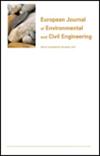Performance of thin reinforced concrete slabs against low velocity repeated impact load
IF 2.3
4区 工程技术
Q2 ENGINEERING, CIVIL
European Journal of Environmental and Civil Engineering
Pub Date : 2023-09-28
DOI:10.1080/19648189.2023.2259956
引用次数: 1
Abstract
AbstractThe use of thin reinforced concrete slabs for buildings has more advantages than beam supported slabs, slabs with column capitals, and drop-down panels because of its easier construction and economic feasibility. However, it is susceptible to localized failure due to punching shear resulting in progressive collapse of the structure. Therefore, the attempt has been made to study the behaviour of thin reinforced concrete slabs 1200 × 1200 mm having thicknesses of 50 and 30 mm under repeated loading through the experiment and simulations. The mass of the impactor was 60 kg with 35 and 70° angular motion and the corresponding impact velocity were 2.62 and 4.97 m/s, respectively. Based on the member response under static conditions using analytical methods, the flexural failure was found to be more prominent and the ultimate flexural load for 50 mm thick slab was found to be 101.7% higher as compared to 30 mm thick slab. It was concluded that the resistance of the target was found to increase by 36% when the target thickness increased from 30 to 50 mm at 35° pendulum impact whereas the same was found to be 63% increment at 70° pendulum impact, during the first impact. Under repeated impacts, the impulse on both 30 and 50 mm thick slab was found to decrease gradually against 35° pendulum impact whereas the abrupt decrease in impulse was observed at 70° impact. The numerical analysis was performed using ABAQUS/EXPLICIT to predict the response of the slab under multi-impact loading. The numerical model was able to accurately predict the peak impact force on both 30- and 50-mm thick slab, up to the fourth impact.Keywords: Reinforced concrete slablow velocity impactexperimentssimulationsrepeated impact load Disclosure statementNo potential conflict of interest was reported by the author(s).Data availability statementThe authors confirm that the data supporting the findings of this study are available within the article.钢筋混凝土薄板抗低速重复冲击荷载的性能研究
【摘要】建筑采用钢筋混凝土薄板比梁支板、柱头板、下拉板施工方便,经济可行,具有诸多优点。然而,由于冲孔剪切的作用,结构容易发生局部破坏,从而导致结构的逐渐坍塌。因此,通过试验和模拟,研究了厚度为50和30 mm的1200 × 1200 mm薄钢筋混凝土板在重复荷载作用下的性能。冲击器质量为60 kg,进行35°和70°角运动,相应的冲击速度分别为2.62和4.97 m/s。基于静力条件下构件的响应分析方法,发现50mm厚板的弯曲破坏更为突出,极限弯曲荷载比30mm厚板高101.7%。结果表明,在35°摆锤冲击下,当目标厚度从30 mm增加到50 mm时,目标的阻力增加了36%,而在70°摆锤冲击下,第一次冲击时,目标的阻力增加了63%。在反复冲击下,30和50 mm厚板在35°摆锤冲击下的冲击冲量逐渐减小,而在70°摆锤冲击下的冲击冲量突然减小。采用ABAQUS/EXPLICIT软件对板坯在多次冲击荷载作用下的响应进行了数值分析。该数值模型能够准确预测30和50毫米厚板坯的峰值冲击力,直至第四次冲击。关键词:钢筋混凝土缓低速冲击实验模拟重复冲击载荷披露声明作者未报告潜在利益冲突。数据可用性声明作者确认在文章中可以获得支持本研究结果的数据。
本文章由计算机程序翻译,如有差异,请以英文原文为准。
求助全文
约1分钟内获得全文
求助全文
来源期刊

European Journal of Environmental and Civil Engineering
ENGINEERING, CIVIL-ENGINEERING, GEOLOGICAL
CiteScore
4.80
自引率
4.80%
发文量
153
审稿时长
6 months
期刊介绍:
The European Research Area has now become a reality. The prime objective of the EJECE is to fully document advances in International scientific and technical research in the fields of sustainable construction and soil engineering. In particular regard to the latter, the environmental preservation of natural media (soils and rocks) and the mitigation of soil-related risks are now not only major societal challenges, but they are also the source of scientific and technical developments that could be extremely beneficial.
 求助内容:
求助内容: 应助结果提醒方式:
应助结果提醒方式:


